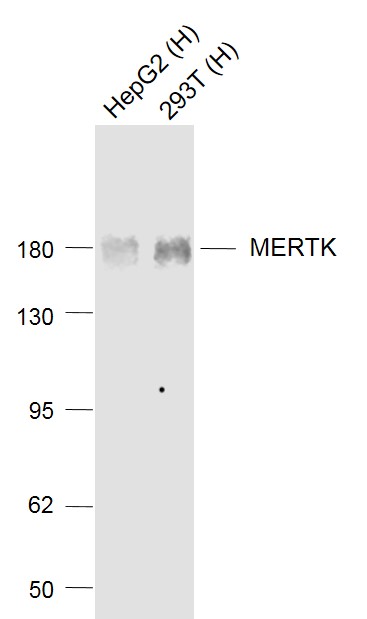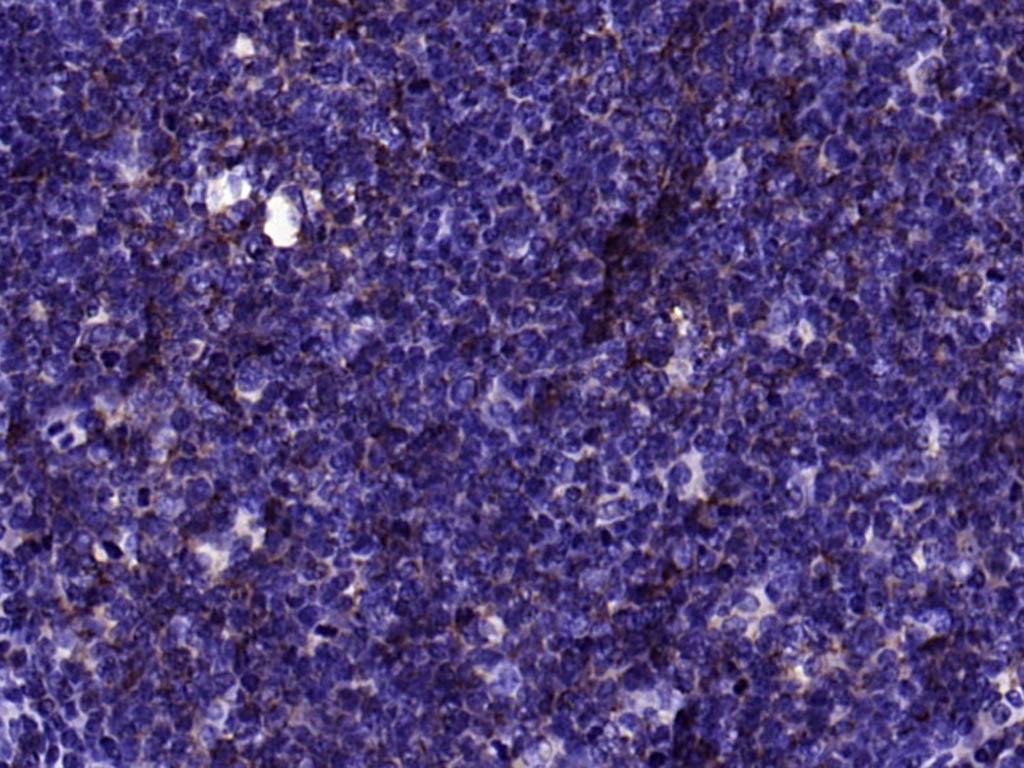
Rabbit Anti-MERTK antibody
MERTK_HUMAN; Tyrosine-protein kinase Mer; Proto-oncogene c-Mer; Receptor tyrosine kinase MerTK; MER; MER proto-oncogene, tyrosine kinase; RP38; c-Eyk; c-mer; Tyro12.
View History [Clear]
Details
Product Name MERTK Chinese Name MERTKRecombinant rabbit monoclonal anti Alias MERTK_HUMAN; Tyrosine-protein kinase Mer; Proto-oncogene c-Mer; Receptor tyrosine kinase MerTK; MER; MER proto-oncogene, tyrosine kinase; RP38; c-Eyk; c-mer; Tyro12. literatures Research Area Tumour Immunogen Species Rabbit Clonality Monoclonal Clone NO. 1C11 React Species Human, Applications WB=1:500-2000 IP=1:10-50 IHC-P=1:50-200 IHC-F=1:50-200 (Paraffin sections need antigen repair)
not yet tested in other applications.
optimal dilutions/concentrations should be determined by the end user.Theoretical molecular weight 108kDa Cellular localization The cell membrane Form Liquid Concentration 1mg/ml immunogen Recombinant human MERTK protein Lsotype IgG Purification affinity purified by Protein A Buffer Solution 0.01M TBS(pH7.4) with 1% BSA, 0.03% Proclin300 and 50% Glycerol. Storage Shipped at 4℃. Store at -20 °C for one year. Avoid repeated freeze/thaw cycles. Attention This product as supplied is intended for research use only, not for use in human, therapeutic or diagnostic applications. PubMed PubMed Product Detail The Major Facilitator Superfamily (MFS) is a large and diverse group of secondary transporters that includes uniporters, symporters, and antiporters. MFS proteins facilitate the transport across cytoplasmic or internal membranes of a variety of substrates including ions, sugar phosphates, drugs, neurotransmitters, nucleosides, amino acids, and peptides. They do so using the electrochemical potential of the transported substrates. Uniporters transport a single substrate, while symporters and antiporters transport two substrates in the same or in opposite directions, respectively, across membranes. Peptide-transporters 2 [solute carrier family 15 (H+/peptide transporter), member 2; SLC15A2; PEPT2 ; Oligopeptide transporter, kidney isoform ; Kidney H(+)/peptide cotransporter; ].
Function:
Receptor tyrosine kinase that transduces signals from the extracellular matrix into the cytoplasm by binding to several ligands including LGALS3, TUB, TULP1 or GAS6. Regulates many physiological processes including cell survival, migration, differentiation, and phagocytosis of apoptotic cells (efferocytosis). Ligand binding at the cell surface induces autophosphorylation of MERTK on its intracellular domain that provides docking sites for downstream signaling molecules. Following activation by ligand, interacts with GRB2 or PLCG2 and induces phosphorylation of MAPK1, MAPK2, FAK/PTK2 or RAC1. MERTK signaling plays a role in various processes such as macrophage clearance of apoptotic cells, platelet aggregation, cytoskeleton reorganization and engulfment. Functions in the retinal pigment epithelium (RPE) as a regulator of rod outer segments fragments phagocytosis. Plays also an important role in inhibition of Toll-like receptors (TLRs)-mediated innate immune response by activating STAT1, which selectively induces production of suppressors of cytokine signaling SOCS1 and SOCS3.
Subunit:
Interacts (upon activation) with TNK2; stimulates TNK2 autophosphorylation. Interacts (via N-terminus) with extracellular ligands LGALS3, TUB, TULP1 and GAS6. Interacts with VAV1 in a phosphotyrosine-independent manner.
Subcellular Location:
Membrane; Single-pass type I membrane protein.
Tissue Specificity:
Expressed predominantly in the hematopoietic lineages: macrophages, NK cells, NKT cells, dendritic cells and platelets.
Post-translational modifications:
Autophosphorylated on Tyr-744, Tyr-748 and Tyr-749 in the activation loop allowing full activity. Autophosphorylated on Tyr-867 leading to recruitment of downstream partners of the signaling cascade such as PLCG2.
Similarity:
Belongs to the protein kinase superfamily. Tyr protein kinase family. AXL/UFO subfamily.
Contains 2 fibronectin type-III domains.
Contains 2 Ig-like C2-type (immunoglobulin-like) domains.
Contains 1 protein kinase domain.
SWISS:
Q12866
Gene ID:
10461
Database links:Entrez Gene: 10461 Human
Omim: 604705 Human
SwissProt: Q12866 Human
Unigene: 306178 Human
Product Picture
Lane 1: HepG2 (Human) Cell Lysate at 30 ug
Lane 2: 293T (Human) Cell Lysate at 30 ug
Primary: Anti-MERTK (SLM-52273R) at 1/1000 dilution
Secondary: IRDye800CW Goat Anti-Rabbit IgG at 1/20000 dilution
Predicted band size: 180 kD
Observed band size: 180 kD
Paraformaldehyde-fixed, paraffin embedded (human tonsil tissue); Antigen retrieval by boiling in sodium citrate buffer (pH6.0) for 15min; Block endogenous peroxidase by 3% hydrogen peroxide for 20 minutes; Blocking buffer (normal goat serum) at 37°C for 30min; Antibody incubation with (MERTK) Monoclonal Antibody, Unconjugated (SLM-52273R) at 1:200 overnight at 4°C, followed by operating according to SP Kit(Rabbit) (sp-0023) instructionsand DAB staining.
References (0)
No References
Bought notes(bought amounts latest0)
No one bought this product
User Comment(Total0User Comment Num)
- No comment




 +86 571 56623320
+86 571 56623320
 +86 18668110335
+86 18668110335

